
 Crisis on Earth-Prime
(DC)
Crisis on Earth-Prime
(DC)written by Gerry Conway and Roy Thomas
art by Don Heck, Adrian Gonzales, Jerry Ordway
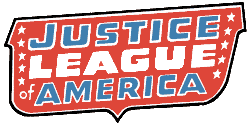
|
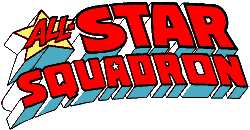
|
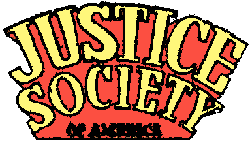
|
Justice League of America #207-209 and
All-Star Squadron #15,16
Rating:
![]() More than a decade afterward, the debate still rages: "Was Crisis on Infinite Earths necessary to make the DC Universe understandable?" The feeling among the folks at DC at the time was that it was: The multiple Earths caused confusion about which character shared a world with which, how one version of a character differed from his doppelganger on another Earth, etc. The feeling among many fans is that it was not: The parallel worlds were well-explained in the stories they affected, were unimportant to most stories anyway, and gave the writers a lot of flexibility.
More than a decade afterward, the debate still rages: "Was Crisis on Infinite Earths necessary to make the DC Universe understandable?" The feeling among the folks at DC at the time was that it was: The multiple Earths caused confusion about which character shared a world with which, how one version of a character differed from his doppelganger on another Earth, etc. The feeling among many fans is that it was not: The parallel worlds were well-explained in the stories they affected, were unimportant to most stories anyway, and gave the writers a lot of flexibility.
![]() Well, if there was ever a story to stretch the Multiverse to its limit, "Crisis on Earth-Prime" is it. Every year, the Justice League of America on Earth-One would have a meeting with their (mostly elder) counterparts on Earth-Two, the Justice Society of America. Inevitably, some crisis would arise, and they'd team up to deal with it. So we had "Crisis Above Earth-One", "Crisis on Earth-Two", "Crisis from Tomorrow", and so forth.
Well, if there was ever a story to stretch the Multiverse to its limit, "Crisis on Earth-Prime" is it. Every year, the Justice League of America on Earth-One would have a meeting with their (mostly elder) counterparts on Earth-Two, the Justice Society of America. Inevitably, some crisis would arise, and they'd team up to deal with it. So we had "Crisis Above Earth-One", "Crisis on Earth-Two", "Crisis from Tomorrow", and so forth.
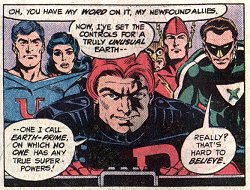
![]() For the 20th annual team-up, the creators pulled out nearly all of the stops. As usual, it would include the heroes of Earth-One and Earth-Two, but 1982's crisis was also to affect Earth-Prime, the comic-book name for the world on which we, the readers live! The team-up would include not only the JLA and JSA, but the All-Star Squadron, a superhero-team whose ongoing series (set during World War II) had started the previous year. And for the sake of something approaching completeness, it also included the super-team of Earth-Three: the Crime Syndicate, composed of evil doppelgangers of the key heroes we know and love. And what the Heck, let's make it a time-travel story as well, taking place in 1982 (the year the story came out), 1942 (the year the All-Stars were in), 1962 (the year of the Cuban Missile Crisis, which features prominently in the villain's plans), and 1947 (the year in which the central villain Per Degaton first appeared)!
For the 20th annual team-up, the creators pulled out nearly all of the stops. As usual, it would include the heroes of Earth-One and Earth-Two, but 1982's crisis was also to affect Earth-Prime, the comic-book name for the world on which we, the readers live! The team-up would include not only the JLA and JSA, but the All-Star Squadron, a superhero-team whose ongoing series (set during World War II) had started the previous year. And for the sake of something approaching completeness, it also included the super-team of Earth-Three: the Crime Syndicate, composed of evil doppelgangers of the key heroes we know and love. And what the Heck, let's make it a time-travel story as well, taking place in 1982 (the year the story came out), 1942 (the year the All-Stars were in), 1962 (the year of the Cuban Missile Crisis, which features prominently in the villain's plans), and 1947 (the year in which the central villain Per Degaton first appeared)!
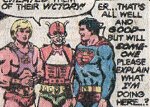
![]() (And to make this multiplicity of universes utterly ridiculous, there was also a preview for a new Masters of the Universe series, featuring a guest appearance by Superman. This story was inserted into one issue each of Justice League of America and All-Star Squadron during this crossover. It doesn't tie into the story, but... geez!)
(And to make this multiplicity of universes utterly ridiculous, there was also a preview for a new Masters of the Universe series, featuring a guest appearance by Superman. This story was inserted into one issue each of Justice League of America and All-Star Squadron during this crossover. It doesn't tie into the story, but... geez!)
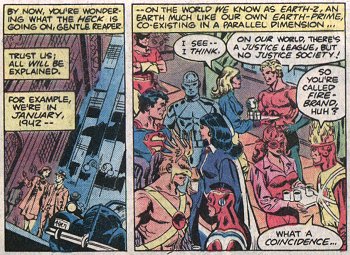
![]() For the record, here's the roll call:
For the record, here's the roll call:
Justic League (Earth-1, 1982) Aquaman, Firestorm, Hawkman (Katar Hol), Superman, Zatanna
Justice Society (Earth-2, 1982) Dr. Fate, Green Lantern (Alan Scott), Huntress, Power Girl, Starman
All-Star Squadron (Earth-2, 1942): Firebrand, Johnny (Chambers) Quick, Liberty Belle, Robotman, (Commander) Steel
Crime Syndicate (Earth-3): Johnny Quick, Owlman, Power Ring, Superwoman, Ultraman (respectively analogs of Flash, Batman, Green Lantern, Wonder Woman, and Superman)
...and lest we forget, the main villain (Earth-2, 1947): Per Degaton!
![]() Writers Gerry Conway and Roy Thomas and editor Len Wein tried, they really did. They included explanatory captions at the beginning of each each issue, hoping to explain the various Earths, the legion of characters, the several time periods, and... oh yeah, the story so far. I still got a bit confused at times... and I knew pretty much everyone, and was reading one issue right after the other. The problem, however, was not so much the existence of parallel worlds, but the attempt to include so darn many of them in the plot.
Writers Gerry Conway and Roy Thomas and editor Len Wein tried, they really did. They included explanatory captions at the beginning of each each issue, hoping to explain the various Earths, the legion of characters, the several time periods, and... oh yeah, the story so far. I still got a bit confused at times... and I knew pretty much everyone, and was reading one issue right after the other. The problem, however, was not so much the existence of parallel worlds, but the attempt to include so darn many of them in the plot.
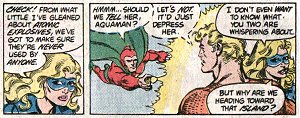
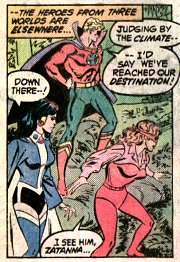
![]() The story is somewhat comprehensible, thanks to the time-honoured technique of breaking the assembled heroes into smaller teams to take on different parts of the problem they're faced with. By no coincidence whatsoever, the five teams are each composed of one member from each of the three superhero teams, and they each face down one member of the Crime Syndicate. These sequences were kinda neat, as the provided ample opportunities for the kinds of scenes inter-universe crossovers are best for: putting incongruous characters together and seeing them interact. For example: the non-powered Huntress, WWII speedster Johnny Quick, and the modern Hawkman comparing notes, then going up against an evil powerhouse like Power Ring... or Superman, a mystic like Dr. Fate, and old-fashioned Robotman nearly getting clobbered in space by the kryptonite-empowered Ultraman.
The story is somewhat comprehensible, thanks to the time-honoured technique of breaking the assembled heroes into smaller teams to take on different parts of the problem they're faced with. By no coincidence whatsoever, the five teams are each composed of one member from each of the three superhero teams, and they each face down one member of the Crime Syndicate. These sequences were kinda neat, as the provided ample opportunities for the kinds of scenes inter-universe crossovers are best for: putting incongruous characters together and seeing them interact. For example: the non-powered Huntress, WWII speedster Johnny Quick, and the modern Hawkman comparing notes, then going up against an evil powerhouse like Power Ring... or Superman, a mystic like Dr. Fate, and old-fashioned Robotman nearly getting clobbered in space by the kryptonite-empowered Ultraman.
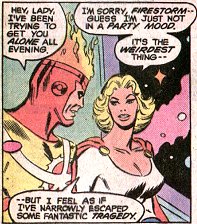
![]() I don't think this crossover can really settle the debate for/against the changes wrought by the big Crisis (the one on Infinite Earths). In many ways, Crisis on Earth-Prime demonstrates both the richness and of the multiple Earths as a source of characters, and the potential for large-scale confusion if not handled with care. And of course it's impossible to weigh all of this properly without comparing it to the Universe that replaced the Multiverse, about which there are also widely divergent opinions.
I don't think this crossover can really settle the debate for/against the changes wrought by the big Crisis (the one on Infinite Earths). In many ways, Crisis on Earth-Prime demonstrates both the richness and of the multiple Earths as a source of characters, and the potential for large-scale confusion if not handled with care. And of course it's impossible to weigh all of this properly without comparing it to the Universe that replaced the Multiverse, about which there are also widely divergent opinions.
![]() Personally, I'm an ecumenical agnostic. I don't know if eliminating the Multiverse of this story (and so many others) was a good thing or bad thing in the grand scheme of comicdom; there's a trade-off with too many might've-beens. And I think there's room in comics for both a Multiverse and a Universe... provided you have enough shelves.
Personally, I'm an ecumenical agnostic. I don't know if eliminating the Multiverse of this story (and so many others) was a good thing or bad thing in the grand scheme of comicdom; there's a trade-off with too many might've-beens. And I think there's room in comics for both a Multiverse and a Universe... provided you have enough shelves.
![]()

© Todd VerBeek, Radio ZeroTM